The FY2025 fiscal year ends on June 30, 2025. Click here for more information about the 2025-2026 budget, including rates.
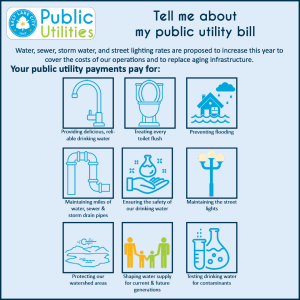
Describe 2024-2025 rate increases in general.
For fiscal year 2025 (July 1, 2024 – June 30, 2025), we have proposed a 4% rate increase to our rates for our water and sewer utilities. We are also proposing 10% increases for the stormwater and street lighting utilities. This year, we have also proposed rate stabilization fees for our water and sewer utilities. These fees are dependent on the customer’s meter size.
A chart showing the average impact on monthly bills for different types of customers with varying usage rates is shown below for reference. More details about the specific impacts to each utility’s rates and about the rate stabilization fee can be found below.
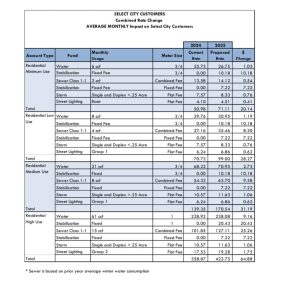
What are the proposed impacts to water rates for 2024-2025?
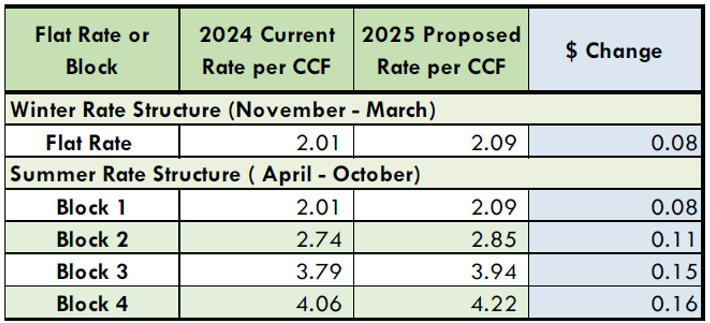
What are the proposed impacts to sewer rates for 2024-2025?
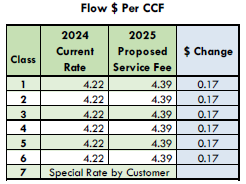
The table above provides the proposed rate change for sewer flows per CCF. Sewer charges may assessed in other methods. Please refer to page 71 of the complete budget for more detailed information about proposed sewer rates.
What are the proposed impacts to stormwater rates for 2024-2025?
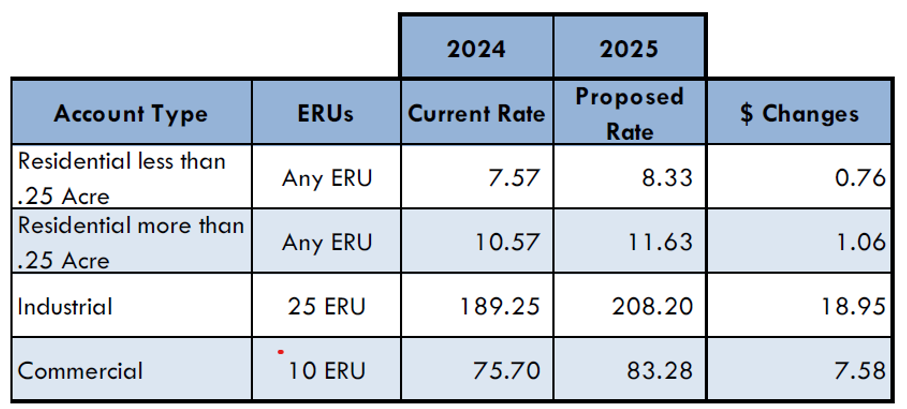
What are the proposed impacts to street lighting rates for 2024-2025?

What fixed fees have been proposed for the water utility for 2024-2025?
We have proposed adding a monthly rate stabilization fee to the water utility rate structure in 2024-2025. Over recent years, water rate revenues have been negatively impacted by significant decreases in water usage. At the same time, the water utility is impacted by costs associated with inflationary pressures and the need to rehabilitate and replace aging water infrastructure. After thoughtful consideration and study, we have determined that offsetting these revenue and cost impacts cannot solely depend on increasing water usage rates (the price each customer pays for the water they use) as this is not sustainable or equitable. Fixed fees are a more reliable method to support the water utility’s finances moving forward.

What fixed fees have been proposed for the sewer utility for 2024-2025?
We have proposed adding a monthly rate stabilization fee to the sewer utility rate structure in 2024-2025. Sewer rate revenues have been negatively impacted by decreases in water usage. At the same time, the sewer utility is impacted by costs associated with inflationary pressures and the need to rehabilitate and replace aging infrastructure. We are replacing Salt Lake City’s Water Reclamation Facility, which is now over 60 years old. Age and updated regulatory requirements make this project critical and timely. This project is generational. Click here to learn more about the New Water Reclamation Facility project. After thoughtful consideration and study, we have determined that offsetting these revenue and costs impacts cannot solely depend on increasing sewer usage rates (the price each customer pays for the sewer they use) as this is not sustainable or equitable. Fixed fees are a more reliable method to support the sewer utility’s finances moving forward.
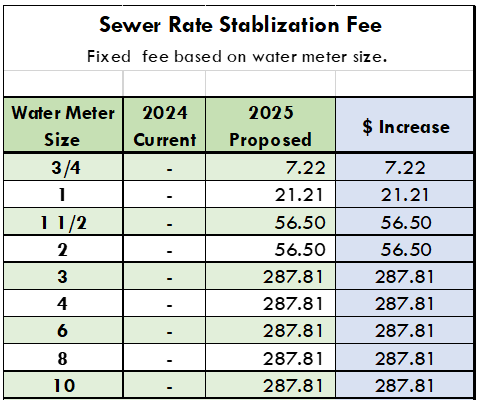
What is the intent of water and sewer rate stabilization fees?
Water and sewer rate stabilization fees were implemented to incorporate revenue reliability for SLCDPU during fiscal year 2025 (FY2025), after multiple years of decreased revenue due to reductions in water use and other factors. These rate stabilization fees are not intended for long-term use or to be a permanent fixture in SLCDPU’s rate structure. Rather, Salt Lake City is currently conducting a rate study with the goal of evaluating the overall structure of our public utility rates, paying particular attention to values like affordability, equity, clarity, and revenue reliability. At the conclusion of this rate study, a new rate structure will be recommended. The recommendation will move through Salt Lake City’s regular review and approval process. We expect the recommended rate structure will be reviewed during Salt Lake City’s FY2026 budget cycle, with the goal of implementing a new rate structure beginning July 1, 2025. The rate study concluded in fall 2024. You can find details about the rate study recommendations online. You can also find information about SLCDPU’s 2025-2026 budget proposal on our webpage.
Why do customers living within Salt Lake City’s boundaries pay different public utility rates than customers living in the service area beyond Salt Lake City?
We provide four public utilities to our customers who reside within Salt Lake City’s boundaries: water, sewer, stormwater, and street lighting. Salt Lake City customers will see charges for each of these utilities included on their monthly bill. Salt Lake City customers will also see charges for waste and recycling collection, operations which are managed by Salt Lake City’s Department of Sustainability. For the convenience of our residents, all public utility and waste & recycling charges are combined to one monthly bill. By contrast, we provide only water service to our customers who reside within our service area but beyond Salt Lake City’s boundaries. Local municipalities or Salt Lake County provide sewer, stormwater, street lighting, and waste & recycling services to these customers.
Years ago, our service area was limited to Salt Lake City only. Accordingly, the rates those customers paid were used to invest in growing infrastructure throughout the service area. When the service area was expanded to include customers outside the City’s boundaries, the rate structure for those customers was created to reflect repayment of those initial investments. In addition, Salt Lake City residents pay a property tax to the Metropolitan Water District of Salt Lake and Sandy for water infrastructure and water supply that benefits the entire water service area, both inside and outside Salt Lake City’s boundaries. Water customers outside of Salt Lake City’s boundaries do not pay this tax.
The chart below lists the impact of fixed fees on customers in Salt Lake County during FY2025.
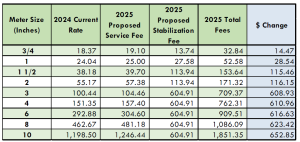
Click here or call our customer service team at 801-535-6900 for more details about your public utility bill.
When you reference “infrastructure,” what does that mean?
The term “infrastructure” refers to the vast network of structures and facilities which are all part of our public utility operations. Much of our infrastructure exists generally out of sight from most people, in the form of water, sewer, and stormwater pipes; treatment plants; pump stations; and dams and reservoirs. Simply put, this critical infrastructure treats water to strict regulatory standards, conveys water from its source to your home, carries wastewater (the water flushed or drained in local homes and businesses) to Salt Lake City’s Water Reclamation Facility, and transports stormwater (the water which is collected from weather events like rain or snow storms, and subsequent melting) to our local water bodies. Salt Lake City’s water and sewer pipe networks are some of the oldest in the State of Utah. Every day, our excellent operations and maintenance crews conduct preventative, planned, and emergent repairs to our system. Our preventative and planned maintenance helps us to minimize costs and avoid emergencies.
While much of our infrastructure exists underground, vertical infrastructure is a critical factor in our public utility operations. Vertical infrastructure refers to those buildings, facilities, and other structures which are built aboveground. Our vertical infrastructure include facilities from sewer lift stations all the way to our New Water Reclamation Facility, water treatment plants, and so many other structures. Vertical infrastructure projects tend to be larger and more complex; when we identify the need to repair, upgrade, or replace these facilities, they come at a larger cost but they are also necessary.
We have over 200 projects currently underway, with a wide variation in size, impact, and criticality. A few of those projects include:
- New Water Reclamation Facility
- City Creek Water Treatment Plant
- Mountain Dell Dam rehabilitation
- Upsizing the sewer main on 2100 South
- Realigning the sewer main on 1800 North
- Implementing the Street Lighting Master Plan
- Rehabilitating storm water drainage on 1100 East
What other programs are supported by public utility rates?
In addition to regular operations and maintenance, our team is responsible for creating and implementing several programs to the benefit of community members throughout our service area. Some programs are designed to support our regular operations. Our Watershed Management Plan, for example, provides a structure by which we can provide the best protection possible to areas where we source our delicious and high-quality water. Other programs are intended to give our customers resources, like those developed by our Water Conservation team to empower customers to use water more efficiently. Finally, there are programs which are created to help us meet regulations and mandates, which often protect the health and safety of our entire community. Our Lead & Copper program is regulatory in nature and is working to help customers determine whether their home’s water service line is made of lead and what they can do to protect their family’s health and safety in those cases. Regardless of their specific goal, all of our programs are planned to positively impact Salt Lake City and the communities we serve.
Are there resources available for customers who have difficulty paying their monthly public utility bills?
We are proud to have partnered with the Salt Lake City Chapter of the Salvation Army to offer Project Water Assist, a program which provides qualifying Salt Lake City customers with financial aid for their monthly public utility bills. Visit our website to learn more about Project Water Assist.
Can community members help customers who have difficulty paying their monthly public utility bills?
Yes! The success of our Project Water Assist program is dependent on generosity from the Salt Lake City community. Customers may elect to add donations to their monthly SLCDPU payments. If you are interested in supporting this program but are not currently a SLCDPU customer, you can also give by calling our customer service team at 801-483-6900.
Where can I find more detailed information about SLCDPU's proposed budget for 2024-2025?
Click here for more information about Salt Lake City Council’s budget process and learn how you can share feedback.
Click here to see a copy of SLCDPU’s complete 2024-2025 proposed budget
How can I share feedback about the changes proposed for the 2024-2025 budget?
For more information about proposed changes or to share your feedback, you can send us an email or call our Customer Service team at 801-483-6900. SLCDPU rate payers are also invited to attend one of the public budget hearings hosted by the Salt Lake City Council on Tuesday, May 4 or Tuesday, June 21, 2024. Click here for more details about this year’s public budget hearings and how to attend.